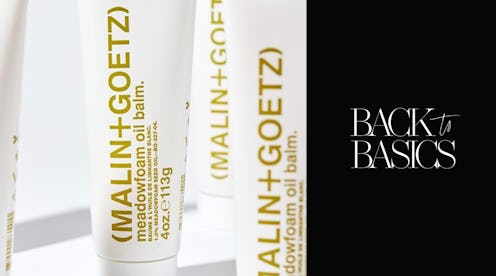(Beauty)
Meadowfoam Seed Oil Is Everywhere In Skin Care — Here's Why

With new product brands, launches, and categories popping up every day, beauty can be a bit overwhelming. Back to Basics, our rudimentary beauty series, serves as your crash course on the science behind some of the best formulations in the game.
There's this thing called the Baader-Meinhof phenomenon. Sort of like catching 11:11 on the clock every time you look up, the frequency illusion happens after you notice something for the first time — then, after that, you start seeing it everywhere. For me, this happened after I first wrote about the meadowfoam seed oil in MALIN+GOETZ's Meadowfoam Oil Balm this January. In the months that've followed, the plant-based oil has been a consistently blinking dot on my radar, popping up in product after product, perpetually at the forefront of ingredient lists. Not quite a trend in its own right, meadowfoam seed oil instead lends support; a silent, workhorse ingredient in everything from foundation to lip color to face oil itself.
And unless you live along the West Coast, you might have never even heard about the plant before. "Meadowfoam seed oil is an antioxidant-rich fatty acid derived from the seeds of the Limnanthes alba (meadowfoam) flower, a winter plant native to the pacific northwest," Jamie Tuazon, director of product development at MALIN+GOETZ, tells The Zoe Report over email. "The oil is extracted from the seeds of the flower."
More specifically, the oil is both stable and non-fragrant, a winning combo in skin care. "It’s composed of 95% long-chain monounsaturated omega-9 fatty acids, making it exceptionally stable in the presence of light and air, meaning it’s unlikely to turn rancid or develop an 'off' odor," explains Bryan Barron, Director of Skincare Research at Paula’s Choice. "Originally an agricultural crop used to manufacture stable compounds for farming practices, the oil is extracted from the seed via a process known as expeller pressing (squeezing the seeds under high pressure) or the oil is extracted using a solvent, most often hexane. Not surprisingly, expeller pressing is more common since it’s more environmentally responsible."
But... why? Out of all the botanical oils in the industry — and there are quite a few — why go to all the trouble of sourcing from a fairly unknown flower? According to Barron, there are a variety of reasons, such as affordability, accessibility, and it being an alternative to "heavier-feeling" silicones. "It’s easy to work into formulas, plays well with numerous other ingredients, and its unique mix of fatty acids gives it distinctive esthetics that work with other oils, emollients, and thickeners to make skin, body, and haircare products feel moisturizing and smooth without the telltale greasy, slick feeling that occurs when too many 'heavier' oils are used."
Tuazon points to the mass appeal meadowfoam seed oil can offer skincare shoppers: "The composition of the oil is also very similar to the skin's sebum," she says. "Due to the composition of the oil and its ability to absorb, this ingredient is suitable for all skin types. Its soothing properties make it ideal for sensitive skin as well."
How it absorbs taps into the formula side of things, though. "The high molecular weight of meadowfoam seed oil doesn’t allow it to absorb into skin," adds Barron. "Instead, it’s really about how it feels once it spreads on skin. It remains liquid at room temperature, spreading easily over skin and setting to a velvety finish that feels much lighter and less greasy than most oils. It seems to absorb quickly but actually remains within skin’s uppermost layers, which is where it does the most good!"
And mark my words: Now that you know all this, you're going to start seeing meadowfoam seed oil everywhere, too. Below, some of the most eye-catching products featuring the ingredient.
We only include products that have been independently selected by The Zoe Report's editorial team. However, we may receive a portion of sales if you purchase a product through a link in this article.
This article was originally published on